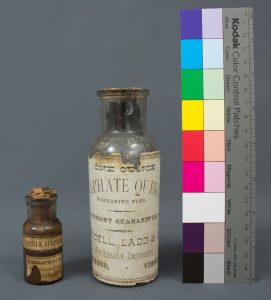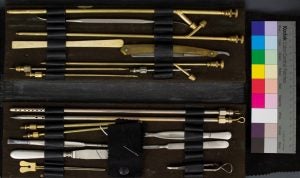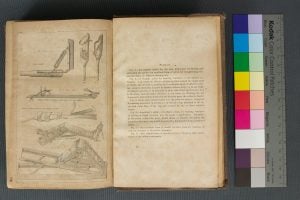Fighting for their Lives: Medical Practices During the American Civil War — An Online Exhibit
Featured below are highlights from the Civil War Medicine exhibit on the 4th Floor of Laupus Library.

*Bottles of Quinine used to treat Malaria on Loan from The Country Doctor Museum.
The American Civil War claimed the lives of soldiers, civilians, and adolescents alike. Battlefield wounds ended the lives of many, but health epidemics also swept across urban areas and army camps. Out of the estimated 700,000 soldiers that died in the Civil War, nearly 465,000 of those deaths were from disease—this outnumbers the entirety of American men killed during WWII.[1] Because of rampant disease and new deadly military tactics, the practice of medicine was stretched past its limits of understanding, resulting in brand-new medical methods and procedures to meet those challenges on all fronts.

*Surgical kit in leather case contains forceps, knives, catheters, and needles on loan from The Country Doctor Museum.
Surgical kits like this one would have gone unwashed throughout most of the day. Inadequate water supplies for cleaning and the steady influx of wounded men who arrived for care prevented doctors from implementing sanitary measures.[2] Also, field hospitals may have only had one kit available and they were often the kits that the surgeons themselves had purchased for private practice.[3]

*A letter from the Division Surgeon to his subordinate outlining the restrictions of alcohol use in surgery dated April 1st, 1865. Held in the Country Doctor Museum Archives.
Although anesthetics were a relatively new discovery, only 0.4% of patients administered with an anesthetic died due to reasons directly attributed to the drugs.[4] This statistic is a testament to the mid-19th century medical training doctors received. Although both Armies were well-stocked with anesthetics like chloroform in the beginning of the war, they often had to resort to alcohol because of shortages, especially by 1865. Doctors and surgeons had to keep strict regulations on the alcohol as the men might turn to abusing it for recreation.

*An excerpt from the Manual of Military Surgery printed in 1864 for use by Confederate doctors.
Despite many of the Union and Confederate surgeons training at The University of Pennsylvania medical school before the war, the South lacked the resources and number of medical care professionals afforded to the North.[5] Manuals like this were published throughout the war to provide guidance to the new or unofficially trained doctors in the Confederacy.
Artifacts and archival material prepared by Laupus Library History Collections will be on exhibit until June 3rd, 2018. To learn more about the experiences of patients of Civil War era medicine, please see Dr. Margaret Humphreys’ presentation found in the bibliography below.
For more information, contact Laupus Library History Collections, HSLHISTMED@ECU.ECU or (252)744-2235.
[1] Humphreys, Margaret MD, PhD. Death and Diversity in Civil War Medicine. Presentation. https://www.youtube.com/watch?v=LtIjtS-4Me4&feature=youtu.be.
[2] Goellnitz, Jenny. Civil War Medicine: An Overview of Medicine. Ohio State University. https://ehistory.osu.edu/exhibitions/cwsurgeon/cwsurgeon/introduction.
[3] Schaadt, Mark J. Civil War Medicine: An Illustrated History. Quincy, Ill.: Cedarwood Publishing, 2000.
[4] Goellnitz. Civil War Medicine: An Overview of Medicine.
[5] Humphreys. Death and Diversity in Civil War Medicine.
